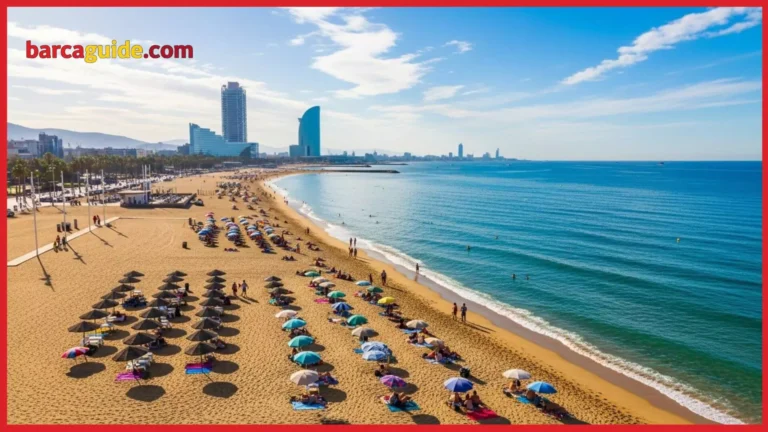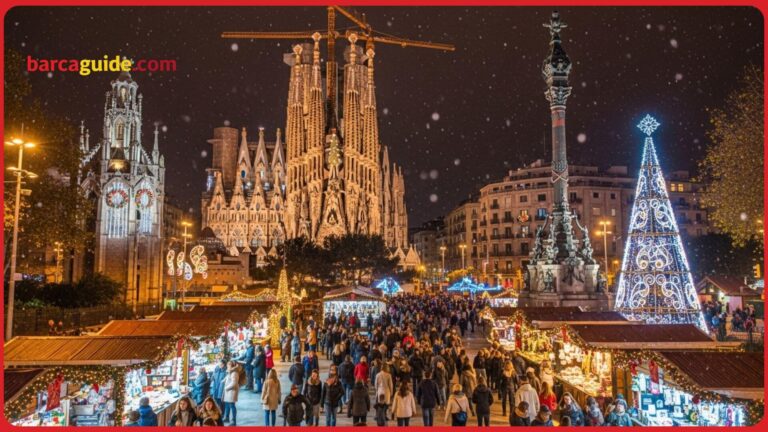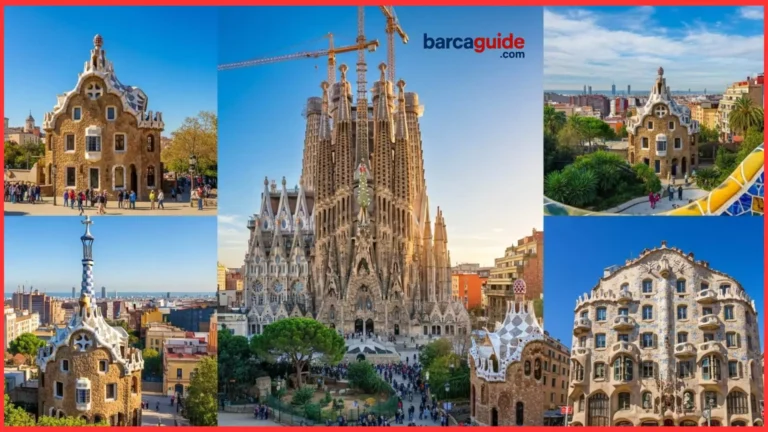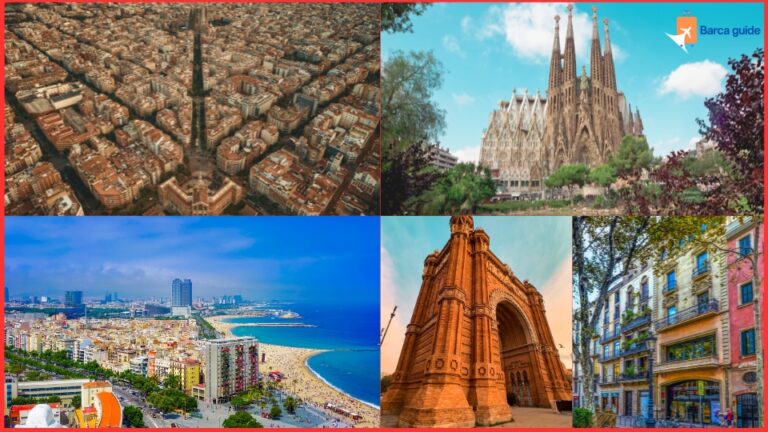Visit FC Barcelona Stadium Camp Nou – Travel Guide
A Global Icon of Football
Camp Nou – this place is absolutely massive and honestly, it’s one of those stadiums that’ll make your jaw drop the second you see it. We’re talking about FC Barcelona’s home since 1957, and it’s not just big, it’s HUGE – like, 99,354 people can fit in there! That’s bigger than most cities I know.
The thing about Camp Nou (which literally means “New Stadium” in Catalan, though it’s not exactly new anymore) is that it’s way more than just a place where they kick a ball around. It’s like the heart of Barcelona’s identity. You know how Barcelona’s motto is “Més que un club” (More than a club)? Yeah, they’re not kidding about that – this stadium is basically a cultural monument disguised as a sports venue.
Why Visiting Camp Nou is a Must
Look, I get it – not everyone’s a football fanatic. But trust me on this one, even if you think football is just 22 people running around after a ball, Camp Nou will change your mind. This isn’t just about the sport; it’s about experiencing something that’s genuinely special.
Walking through the same tunnels that Messi used to strut through before scoring his ridiculous goals? Getting to sit in the same seats where fans have been screaming their heads off for decades? That’s the kind of stuff that gives you goosebumps, football fan or not. Plus, the stories you’ll get out of this visit will definitely make you sound way more interesting at parties.
History of Camp Nou
Construction and Inauguration
So here’s the deal – back in the 1950s, Barcelona had this cute little stadium called Camp de Les Corts, but it was getting way too cramped for their growing fanbase. Kind of like when you outgrow your apartment and need to find a bigger place, except their “bigger place” ended up being the largest stadium in Europe.
The club’s president at the time, Francesc Miró-Sans (great name, right?), basically said “Let’s build something absolutely massive” and got these three architects to design what would become this monster of a stadium. Construction started in 1954, and by September 24, 1957, they were ready to show it off with a match against some Polish players from Warsaw.
Here’s a fun fact – they just called it Estadi del FC Barcelona and everybody called it Camp Nou to distinguish it from the old place. Sometimes, the simplest name just sticks, you know?
Evolution Over the Decades
This place has been through more makeovers than a reality TV star. The biggest one happened in 1982 when they were getting ready for the World Cup – they expanded it to fit 120,000 people! Can you imagine the noise? Unfortunately, safety regulations later brought that number down to where it is now, but still, pretty impressive.
Camp Nou isn’t just about football though. They’ve hosted Olympic ceremonies, massive concerts, and all sorts of events. It’s basically Barcelona’s go-to venue when they want to do something really big and important. Each decade has brought new upgrades, better facilities, and more ways to make fans feel like they’re part of something special.
Modernization and Nou Espai Barça Project
Now here’s where things get really interesting (and expensive). Barcelona is currently spending €1.5 billion – yes, billion with a B – on what they’re calling the Nou Espai Barça project. This isn’t just a renovation; it’s like tearing down your house and building a mansion in its place.
They started this massive project in 2022, and if everything goes according to plan, we should see the stadium partially reopen by September 2025. The new capacity? 111,000 seats! They’re also building a new basketball arena because, why not go all out?
Now, I won’t lie – there have been some hiccups along the way. Construction delays, pitch installation problems, the usual stuff that happens when you’re trying to rebuild an iconic stadium while keeping it running. But hey, Rome wasn’t built in a day, and neither is the world’s most expensive stadium renovation.
Where is Camp Nou Located?
Address and Getting There
Camp Nou sits at Carrer d’Arístides Maillol, 12, in the Les Corts district – basically about 5 kilometers west of Barcelona’s city center. It’s one of those addresses that sounds fancy but is actually pretty easy to find, especially since there are signs everywhere pointing you in the right direction.
The surrounding area of the stadium is pretty neat. It has a nice combination of different residential neighborhoods, commercial spaces, and in that transient space, on match days, the whole area is buzzing with fans, food trucks and the excitement you only seem to get around the big stadiums.
Best Ways to Reach the Stadium
Barcelona’s public transport is honestly pretty great, and getting to Camp Nou is super straightforward. Here are your best bets:
Metro: Take Line 3 (green) to either Les Corts or Maria Cristina station (both within walking distance – you won’t even break a sweat walking!); or if leftover Line 5 (blue) to Collblanc is easier from your accommodations.
Bus: There are tons of bus lines that’ll get you there – 7, 15, 43, 67, 68, 70, 71, 72, 74, 75, and 113. I know, that’s a lot to remember, but honestly, just ask any local or check Google Maps.
Tram: The Tramvia Blau (Blue Tram) is kind of fun if you’re into scenic routes, especially if you’re staying in the upper parts of the city.
Taxi/Uber: Sometimes you just want door-to-door service, and that’s totally fine. Just be aware that traffic can be absolutely mental on match days, so factor in extra time.
Nearby Attractions and Landmarks
While you’re in the area, there are some pretty cool spots worth checking out:
Pedralbes Monastery: This 14th-century Gothic monastery is gorgeous and way more peaceful than the stadium atmosphere. Perfect if you need to decompress after all the football excitement.
Palau Reial de Pedralbes: Former royal palace with some nice museums and gardens. It’s one of those places that makes you feel fancy just by walking through it.
L’Illa Diagonal: A massive shopping center where you can grab food, do some shopping, or just hang out. Great for killing time before or after your stadium visit.
Parc de Cervantes: If you’re into roses (and I mean REALLY into roses), this park has got you covered. It’s surprisingly beautiful and a nice break from all the urban hustle.
Camp Nou Stadium Tour Overview
Types of Tours Offered
Here’s the thing about visiting Camp Nou right now – because of all the construction work, the tour experience is a bit different than it used to be. But don’t worry, it’s still totally worth it! The basic “Camp Nou Experience” gives you access to the museum, whatever parts of the stadium are open, and some interactive zones that are pretty cool.
They’ve got standard tours running most days of the week, with audio guides in a bunch of different languages. There are also VIP experiences if you want to feel extra special, though with the renovation going on, some of the usual VIP areas might not be accessible.
What’s Included in the Tour
The main attraction right now is the FC Barcelona Museum, which is honestly incredible. We’re talking about room after room of trophies, jerseys, and memorabilia that’ll make any sports fan drool. Even if you’re not into football, seeing all those shiny trophies is pretty impressive.
You’ll also get to explore whatever parts of the stadium are open – this usually includes the players’ tunnel (which never gets old), the dugouts, and some pitch-side areas. The multimedia presentations are really well done too, showing historic matches and explaining the club’s history in a way that’s actually entertaining.
The interactive zones are fun – you can test your football skills and learn about the technical side of the game. Plus, those audio guides are actually worth listening to, unlike some tourist attractions where they’re just boring history lessons.
Tips for Getting the Most Out of the Tour
Here’s some friendly advice from someone who’s been there:
Book ahead: Seriously, don’t just show up hoping for the best. Tours sell out, especially during busy periods, and booking online usually gets you better prices anyway.
Weekdays are your ally: Weekends and holidays will be packed. If you can find a way to visit on a weekday, you will be much better off.
Give yourself time: Don’t rush it. Take your time and plan for at least 2 to 3 hours to experience it all. You will see more than you think.
Wear comfortable footwear: You will be walking, a lot of walking – up and down stairs and ramps. Your feet will appreciate it later.
Check the latest updates: With all the construction going on, what’s open can change. Check their website before you go so you know what to expect.
FC Barcelona Museum and Trophy Room
What to Expect Inside
The FC Barcelona Museum is legitimately one of the most visited museums in all of Catalonia, and once you’re inside, you’ll understand why. It’s like walking through the greatest hits of football history, but way more organized and with better lighting.
The museum flows chronologically, starting from when the club was founded in 1899 (yeah, it’s been around for a while) all the way to the present day. Each section is packed with authentic stuff – jerseys that actual players wore, boots that scored famous goals, and personal items from the legends themselves.
What I love about this place is that it’s not just about football. You really get a sense of how Barcelona FC is woven into the fabric of Catalan culture and identity. It’s like a history lesson disguised as a sports museum.
Interactive Exhibits and Immersive Experiences
This is where the museum really shines. They’ve got all this cool tech that makes you feel like you’re actually part of the action. Virtual reality experiences let you “witness” historic matches from perspectives you’d never normally get – it’s like having the best seat in the house for games that happened decades ago.
The touch-screen displays are loaded with stats, player profiles, and behind-the-scenes content that’ll keep you entertained for hours. And those immersive audio-visual experiences? They literally recreate the atmosphere of Camp Nou during big matches. You can hear the crowd roaring, feel the tension during penalty shootouts, and experience the pure joy of championship victories.
It’s the kind of stuff that makes you wish you could time travel back to witness these moments in person. The tech isn’t just flashy for the sake of it – it actually enhances the storytelling in a really meaningful way.
Honoring the Barça Legends
This is where you’ll probably get a bit emotional, even if you’re not a Barcelona fan. The museum does an incredible job of celebrating the players who’ve made this club legendary. There are dedicated sections for icons like Johan Cruyff, who basically revolutionized how Barcelona plays football, and Lionel Messi, whose achievements are so ridiculous they almost don’t seem real.
The trophy room is absolutely bonkers – it’s basically a shrine to success. Multiple Champions League trophies, countless La Liga titles, Copa del Rey victories… it’s like walking through a jewelry store, but for football fans. Each trophy comes with the story of how it was won, the key players involved, and the memorable moments from that season.
They also give props to the coaches who’ve shaped the club, from early pioneers to modern legends like Pep Guardiola. And don’t even get me started on La Masia, Barcelona’s youth academy – seeing how many world-class players they’ve produced is just mind-blowing.
What You Need to Know Right Now (2025)
Okay, let’s talk reality for a second. Because of the massive renovation project, things are a bit different than usual:
- Ticket prices: Tours start at around €28, sometimes you can snag them for €19 on certain days
- What’s open: The museum and modified stadium tours are running, but you won’t get the full stadium experience
- Timeline: They’re aiming for partial reopening by September 2025, with everything finished by the 2025-26 season
- The bottom line: It’s still totally worth visiting, just manage your expectations
For the most up-to-date info and to book tickets, hit up the official FC Barcelona website. Yeah, it’s a bit of a construction zone right now, but you’re literally witnessing history in the making – this renovation is going to be absolutely incredible when it’s done!







